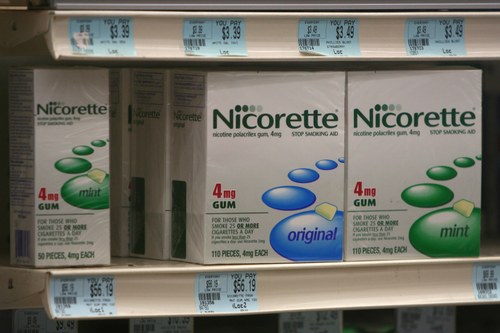
Nixing the patch: Smokers quit cold turkey

Sheri Odom started trying to quit smoking in her mid-20s. At least once a year she would pick up a supply of nicotine patches or nicotine gum, throw out her cigarettes and steel herself to quit.
She would put up with the "slow torture" of the patch or gum regimen, gradually reducing the nicotine dosage. When she finished the treatment and stopped using the product, she would be cranky and irritable. Within three days, she would be smoking again; once, a boyfriend even bought cigarettes for her on the second day.
So Odom, a special education teacher in Springfield, Mo., changed tactics. She decided that those three days--the first three without any nicotine--were going to be bad no matter what. She joined a support group on the Internet, read about nicotine addiction and quit cold turkey in late 2004, while spending Christmas with her family. She figured they would understand if she were cranky.
With the patch, "You're putting off the inevitable that you have to go through anyway, which is the withdrawal from nicotine," said Odom, 40. "I think cold turkey, just from my experience, was the easiest. I just got it over with all at once."

Odom is part of a growing movement of cold turkey quitters who say that nicotine patches, gums and lozenges merely draw out a quitter's withdrawal symptoms while feeding the addiction.
A leading advocate of cold turkey quitting is the Web site whyquit.com. The site encourages smokers to educate themselves thoroughly about nicotine addiction and then quit without first cutting down or using medication.
The site includes links to dozens of studies questioning the effectiveness of products like the patch and gum, collectively known as nicotine replacement therapy, or N.R.T. An American Cancer Society report in 2003 found that nearly 80 percent of ex-smokers said they quit cold turkey. Another study found that 93 percent of over-the-counter N.R.T. users relapse and begin smoking again within six months.
With nicotine replacement therapy, "The levels of long-term success are dismal," said Dr. Michael Siegel, a physician and professor at Boston University's School of Public Health. "More importantly, I think that the role of nicotine replacement therapy as part of a national policy to address smoking cessation has been over emphasized . . . Quitting cold turkey has been the most effective way of quitting smoking."
Quitters like Odom and researchers like Siegel may be shouting into the wind, however. Nicotine replacement therapy is recommended by virtually every government agency and major health organization trying to help people quit -- from the Department of Health and Human Services to the American Cancer Society.
The Surgeon General's Web site states, "The most effective way to quit smoking is by using a combination of counseling and nicotine replacement therapy" or medicines like Zyban. The clinical practice guidelines established by the U.S. Public Health Service in 2000 say that all eligible patients should use drug therapies.
Based on more than 110 clinical studies, nicotine replacement therapy roughly doubles a person's odds of quitting successfully, said Saul Shiffman, a professor of psychology at the University of Pittsburgh who has studied smoking cessation for 30 years.
"The bottom line is that it works," he said. "We just know that it works. It's a consistent finding, study after study."
Shiffman underscored that nicotine from the patch or gum is "not damaging in itself" and said that using nicotine replacement products allows patients to focus on behavioral changes without enduring the worst side effects of nicotine withdrawal.
"Most people use the patch or gum for 10 to 12 weeks. Its real purpose is to get you through that period and launch you on the way to being an ex-smoker," Shiffman said, and if patients relapse later, the product isn't to blame. "It doesn't help everyone forever."
Still, traffic to whyquit.com has grown steadily. John Polito, the site's founder, believes many of those visitors feel the studies and quitting advice on the site confirm their own experiences--that quitters who used N.R.T. return to smoking.
"I ran from miracle cure to miracle cure," said Polito, 52, an attorney and cessation counselor in Charleston, S.C., who smoked three packs a day for 30 years. "I did the patch twice, the gum twice and hypnosis twice." The only thing that worked, he said, was going cold turkey.
Polito started the site in 1999 and a short time later joined forces with Joel Spitzer, who runs cold turkey quitting clinics in Chicago. The site and its sister message board, "Freedom from Tobacco," are free and take no outside financing. Polito and a small volunteer staff pay the sites' costs out-of-pocket.
Spitzer and Polito stress that withdrawal symptoms are at their worst during the three days that it takes for nicotine to be completely flushed out of the body, and that it's better to just get through that period than to wean away with patches and gums. The site gives tips for enduring those three days and learning to modify behavior over the subsequent weeks and months.
Greg Tory, a retired businessman in Tampa, Fla., said he had tried virtually every nicotine replacement product during 35 years of smoking and trying to quit. He used the gum for six months at one point, but returned to smoking, and was using the gum again in early 2005 when he discovered whyquit.com.
"I thought, 'Gosh, this is just crazy, what am I going to do, chew gum for the rest of my life?'" he said. He took a vacation from work. "Basically, I locked myself in my bedroom for three days. I just told my wife, bring me a meal once in a while," he said. Those days were awful, and the next three months were tough. But his thoughts of smoking gradually declined until he went days and weeks without thinking about it.
Researchers are starting to join Polito in questioning the effectiveness of nicotine replacement therapies.
"There is really no good evidence that nicotine replacement therapy in the long run makes a big difference," said K.H. Ginzel, a retired professor of pharmacology, who was one of the earliest critics of N.R.T. when it appeared in the 1980s. "Many studies are just going for one year or less than that, and the smoker is relapsing after that time."
The studies are based on bad science, critics say, because clinical studies of nicotine replacement products aren't truly "blind" because the patients receiving nicotine recognize the sensation and the ones getting a placebo feel the withdrawal. That corrupts the results in a study in which a subject's perceived odds of success are a critical factor.
Also, Siegel has suggested that N.R.T. research is skewed by researchers' conflicts of interest. Eleven of the 17 members of the clinical practice guideline panel had significant financial ties to pharmaceutical companies, he said. Nicotine replacement therapy is an estimated $1 billion a year industry in the United States.
Shiffman, however, defended the panel.
"The committee was rather thoroughly vetted," he said. "The database on which these recommendations are made is there for everyone to see. It's peer reviewed publications."
One thing that everyone agrees on is that there is no easy way to quit.
"There is no silver bullet here. People need to understand that," said Dr. Lowell C. Dale, a physician at the Mayo Clinic's Nicotine Dependence Center and an N.R.T. advocate. "We really encourage them to seek the help of a counselor."
Siegel agreed. "Quitting smoking is probably one of the hardest things that many people will do in their entire lives," he said. "It takes a lot of motivation and a lot of willpower."
E-mail: kjm2121@columbia.edu

